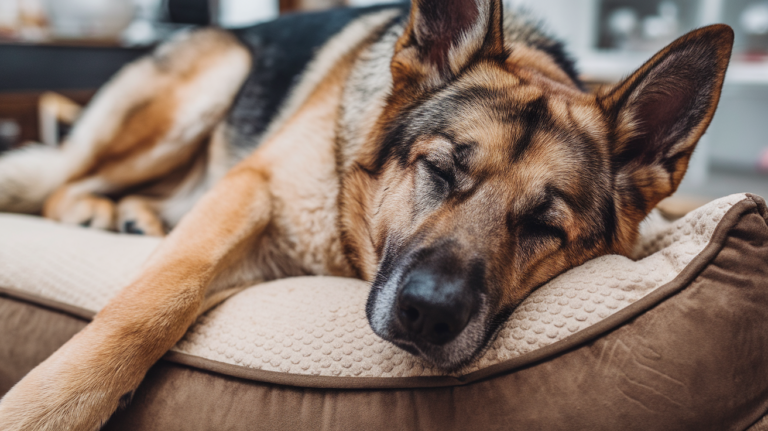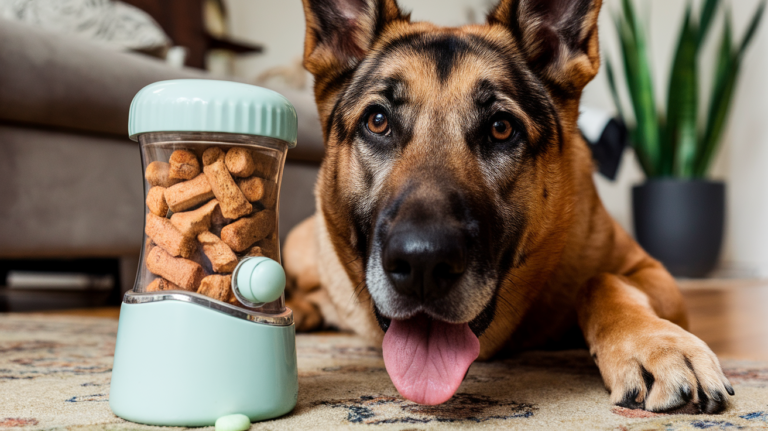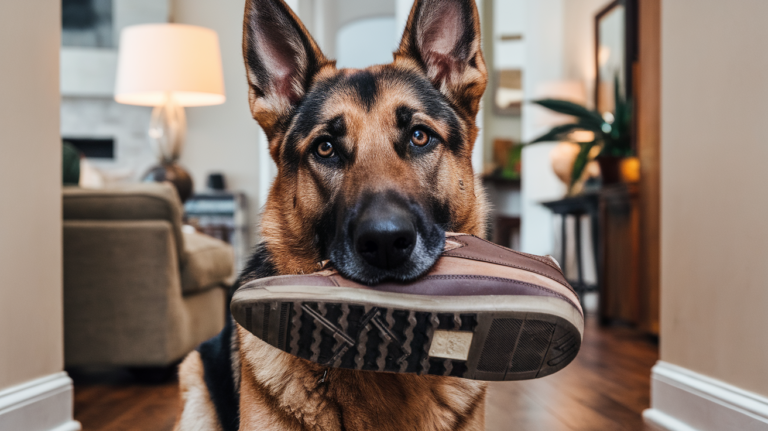Walking your German Shepherd at night can be a rewarding experience, offering a peaceful and cooler environment for exercise. However, it also presents unique challenges that require careful consideration and preparation.
This comprehensive guide will walk you through essential steps to ensure safe and enjoyable nighttime walks with your German Shepherd. By following these guidelines, you’ll be able to create a positive routine that benefits both you and your canine companion while minimizing potential risks associated with low-light conditions.
Step 1. Equip Your Dog with Proper Gear
Before heading out for a nighttime walk, ensure that your German Shepherd is equipped with the appropriate gear. A sturdy leash and well-fitting collar are essential, but consider investing in a harness for added control.
Additionally, a collar light or LED collar can enhance visibility in low-light conditions, making your dog easier to spot. Gear designed for comfort and safety will help keep your pet secure and reduce the risk of accidents during your nightly strolls.
When selecting a leash, opt for one that’s reflective or has built-in LED lights. This not only increases your dog’s visibility but also helps illuminate the path ahead.
For collars and harnesses, choose ones with adjustable straps to ensure a snug fit without restricting movement. Remember that comfort is key – an uncomfortable dog may become agitated or resistant during walks.
Consider the weather conditions as well. If you live in an area with cold nights, a reflective dog jacket can provide both warmth and increased visibility. For rainy climates, waterproof gear can keep your German Shepherd dry and comfortable throughout the walk.
Step 2. Choose a Safe and Familiar Route
Selecting a safe and familiar route is crucial for nighttime walks with your German Shepherd. Stick to well-lit areas where both you and your dog can see clearly. Familiarity with the route helps in predicting any potential hazards such as uneven terrain, busy intersections, or areas with high traffic.
Avoid isolated or poorly lit paths, and opt for routes where you have previously walked during the daytime to ensure a more controlled environment for your evening walks.
Take the time to scout potential routes during daylight hours. Look for areas with good streetlighting, wide sidewalks, and minimal traffic. Parks or residential areas often provide safer environments for nighttime walks. Be aware of local regulations regarding off-leash areas and respect any time restrictions that may be in place.
It’s also wise to have a few alternative routes planned. This allows you to vary your walks, keeping them interesting for both you and your dog, while also ensuring you have backup options if your primary route becomes unavailable or unsafe for any reason.
Step 3. Stay Alert and Aware of Your Surroundings
When walking your German Shepherd at night, it’s important to stay vigilant. Pay close attention to your environment, watching for obstacles, other animals, and potential dangers like speeding vehicles or suspicious behavior.
While it can be tempting to zone out or focus on your phone, maintaining awareness not only ensures your safety but also allows you to respond quickly if your dog becomes agitated or encounters something unexpected.
Use all your senses to stay alert. Listen for approaching vehicles or other animals, and be prepared to react. Keep an eye out for reflections or movement in the shadows that might indicate the presence of wildlife or other dogs.
If you’re using headphones to listen to music or podcasts, keep the volume low enough to hear your surroundings, or consider using only one earbud.
Be particularly cautious at intersections and when passing driveways or alleys. Drivers may have difficulty seeing you and your dog in low-light conditions, so always assume that you need to take extra precautions to make yourself visible and avoid potential accidents.
Step 4. Keep Your Dog on a Short Leash
For greater control, it is advisable to keep your German Shepherd on a short leash during nighttime walks. A shorter leash allows you to quickly rein in your dog if necessary, preventing them from darting into traffic or approaching unknown animals.
This technique also helps maintain better communication and guidance, reinforcing discipline and ensuring that your dog stays close, which is particularly beneficial in low-light conditions where visibility is restricted.
A leash length of about 4-6 feet is generally recommended for nighttime walks. This length provides enough freedom for your dog to move comfortably while allowing you to maintain control. Avoid retractable leashes, as they can make it difficult to quickly control your dog’s movements and may fail in critical moments.
Practice leash control techniques during daytime walks to ensure both you and your German Shepherd are comfortable with the shorter leash before venturing out at night. Teach your dog to walk calmly by your side, responding to gentle leash cues. This will make nighttime walks more manageable and enjoyable for both of you.
Step 5. Bring Essentials and Emergency Supplies
Always come prepared with the essentials when walking your German Shepherd at night. This includes waste bags, water, and a portable bowl to keep your dog hydrated. Additionally, carry a charged cell phone in case you need to contact someone or use a GPS for navigation.
It’s also smart to have a small first-aid kit ready for minor injuries. Emergency supplies can be lifesavers, providing the necessary support in unforeseen circumstances and ensuring that your walk can continue smoothly.
Consider packing a small backpack or fanny pack with these essentials:
- Waste bags and hand sanitizer
- Collapsible water bowl and water bottle
- Basic first-aid supplies (antiseptic wipes, bandages, tweezers)
- Your dog’s ID and vaccination information
- A small flashlight or headlamp as a backup light source
- A few treats to reward good behavior or to distract your dog if needed
It’s also wise to carry some cash and a list of emergency contact numbers, including your veterinarian’s after-hours number. Being prepared for various situations will give you peace of mind and ensure you can handle unexpected events during your nighttime walks.
Step 6. Reflective Gear for Yourself Too
While making sure your dog is visible, don’t overlook your own visibility. Wearing reflective clothing or accessories like vests, armbands, or shoes can make a significant difference. Better visibility means drivers and other pedestrians are more likely to see you, reducing the risk of accidents.
Reflective gear can provide an extra layer of safety, ensuring that both you and your German Shepherd are easily seen during your nighttime excursions.
Invest in high-quality reflective gear that’s comfortable and suitable for various weather conditions. Some options to consider include:
- Reflective running vests or jackets
- Reflective arm or leg bands
- Shoes with reflective elements
- Reflective hats or caps
Remember that reflective gear works by bouncing light back to its source, so it’s most effective when there’s a light source present, such as car headlights. For areas with minimal lighting, consider adding active light sources like clip-on LED lights to your clothing or gear.
Regularly check your reflective gear for wear and tear, replacing items as needed to ensure optimal visibility. By making yourself more visible, you’re not only protecting yourself but also setting a good example for other nighttime walkers in your community.
Step 7. Socialize and Train Your Dog
Prior training and socialization are key to managing your German Shepherd during nighttime walks. A well-socialized dog is less likely to react aggressively to other animals or people, creating a more pleasant walking experience.
Regular obedience training ensures that your dog responds to commands, which is especially important in low-visibility situations. Investing time in socializing and training builds trust and ensures that your German Shepherd is better behaved, making walks safer and more enjoyable for both of you.
Start socializing your German Shepherd from a young age, exposing them to various environments, people, and other animals in positive, controlled settings. This helps reduce anxiety and reactivity during nighttime encounters. Focus on key commands that are particularly useful for nighttime walks, such as:
- “Leave it” – to prevent your dog from picking up or approaching unknown objects
- “Stay” or “Wait” – useful at street crossings or when you need your dog to remain still
- “Heel” – to keep your dog close by your side in areas with limited visibility
- “Quiet” – to manage barking that might disturb neighbors during late-night walks
Practice these commands in various settings and gradually introduce distractions to reinforce the behaviors. Consider enrolling in obedience classes or working with a professional trainer to address any specific behavioral issues.
Remember that training is an ongoing process. Regular practice sessions, even short ones, can help maintain and improve your German Shepherd’s responsiveness to commands. This consistent training will pay off during your nighttime walks, ensuring a safer and more controlled experience for both you and your canine companion.






